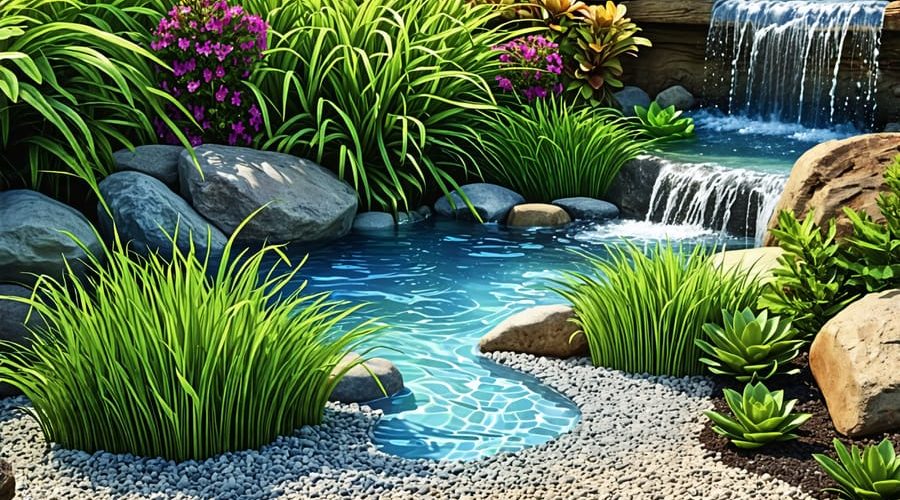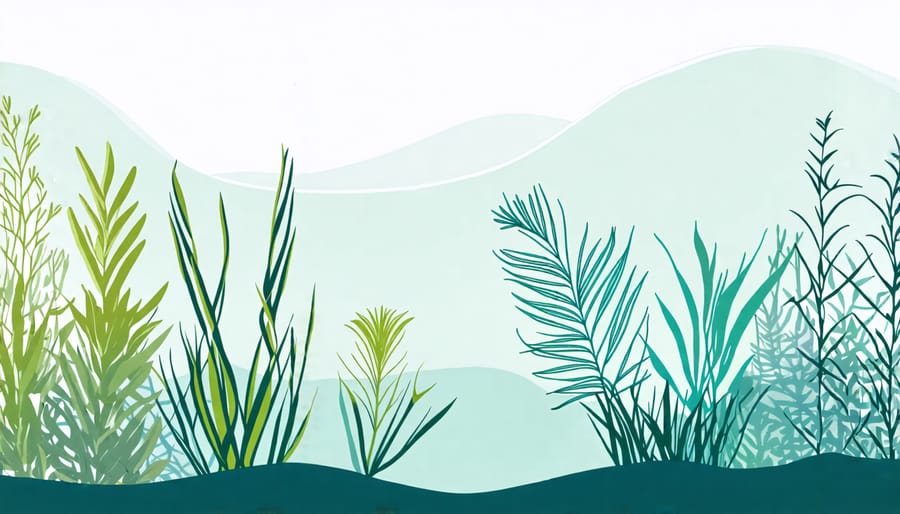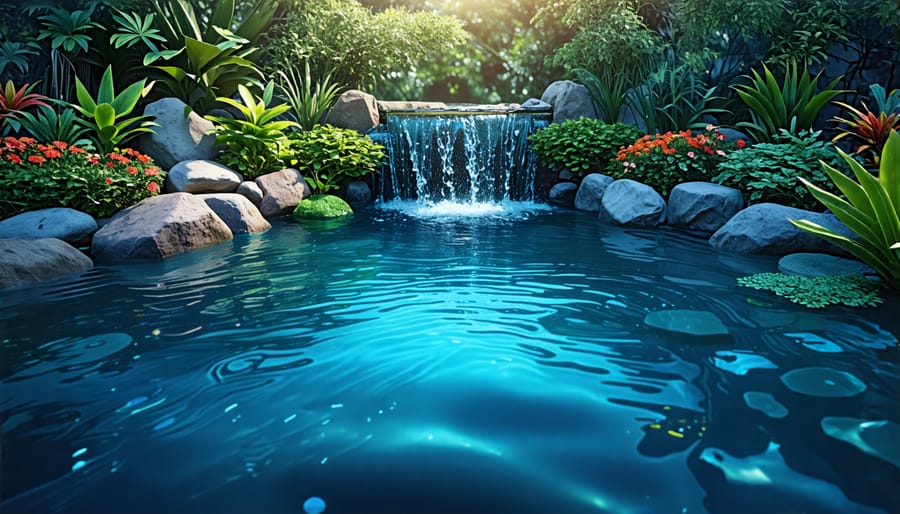
Ocean Plant Adaptations: Unlock the Secrets for Your Water Garden
Transform your pond or water garden by implementing ocean plant adaptations. Begin by selecting salt-tolerant species like eelgrass or widgeon grass, which mirror ocean resilience against fluctuating water conditions. Incorporate a varied substrate by layering sand, gravel, and soil, promoting growth and mimicry of oceanic ecosystems. Ensure water movement through fountains or pumps, simulating tidal dynamics that support essential oxygenation and nutrient distribution. Introduce microhabitats using rocks and driftwood, creating refuges that foster diverse plant and animal life, much like coral reefs. These straightforward steps not only enhance aesthetic appeal but also cultivate a robust and adaptive aquatic environment in your garden oasis.
Understanding Ocean Plant Adaptations
Saltwater Tolerance
Ocean plants are true marvels when it comes to thriving in salty environments, making them an inspiring example for anyone interested in water gardening. These plants have developed unique adaptations to manage salt in their habitats, such as specialized cells that filter out salt and thick, waxy surfaces that help retain fresh water. This remarkable ability allows them to flourish where many other plants cannot, offering us valuable insights into creating resilient and vibrant water gardens.
Imagine integrating some of these adaptive strategies into your pond or water garden. For instance, planting salt-tolerant species can help maintain a balanced aquatic ecosystem even in slightly saline conditions. Think about the rugged beauty of sea lavender or the tough resilience of eelgrass, which not only withstand salt but can also enhance the aesthetic appeal of your garden.
You don’t need to live by the ocean to draw inspiration from these hardy plants. Even my own water garden has benefited from incorporating these principles, like using salt-tolerant plants during a particularly dry season. By mimicking ocean plants’ salt management strategies, you can ensure your water garden thrives despite less-than-ideal water conditions. Embrace these oceanic lessons to enhance your DIY water gardening projects—your pond will thank you for it!

Nutrient Acquisition Strategies
Ocean plants have developed remarkable strategies to acquire nutrients in their underwater environment, and these can inspire exciting ideas for your own pond or water garden. Many aquatic plants rely on their surroundings, absorbing nutrients directly through their leaves from the water. This is a strategy you can mimic by ensuring your pond has nutrient-rich water. Consider adding organic matter to your pond, such as fish-safe fertilizers, to simulate this natural nutrient cycle.
Another fascinating adaptation is the ability of some ocean plants to harbor symbiotic relationships. Certain plants host algae or bacteria within their tissues that help in nutrient acquisition through photosynthesis or nitrogen fixation. In your pond, introducing certain beneficial bacteria can help maintain nutrient levels and promote plant growth, creating a balanced ecosystem.
Root systems play a vital role too. Some ocean plants extend their roots into the sediment to extract essential nutrients. To replicate this, stock your pond with a mix of floating and rooted plants. Use gravel or aquatic soil to anchor plants, and watch how this setup supports healthy nutrient uptake.
By combining these strategies, you can create a thriving, self-sustaining pond environment. It’s all about blending creativity with nature’s guidance—something every water gardener can delight in.

Resilience to Water Pressure and Currents
Ocean plants thrive in ever-changing water conditions by developing unique adaptations to withstand pressure and currents. These plants often have flexible, streamlined structures that reduce resistance, allowing them to sway rather than break under strong forces. Think of kelp forests swaying gracefully; their strength lies in their flexibility. Many ocean plants also possess strong root systems or holdfasts to anchor themselves securely to the ocean floor. For water garden enthusiasts, incorporating similar resilient features can transform your garden into a thriving oasis. Consider plants with pliable stems and secure anchoring methods, ensuring your garden flourishes amid flowing water.
Incorporating Ocean-Inspired Adaptations in Your Water Garden
Choosing the Right Plants
Selecting the right water plants for your pond can transform your backyard into an oceanic paradise, full of resilience and charm. Start by considering plants known for their hardy nature, mimicking ocean flora’s adaptability. For instance, choose species that can withstand varying water temperatures and salinity levels, much like their ocean counterparts. Salt-tolerant plants, such as certain types of seagrass or sea lettuce, are excellent choices in environments where water conditions may not always be ideal.
Think about your pond’s depth and sunlight exposure, as these factors play a significant role in plant growth. Floating plants like water lilies can provide shade and reduce algae, much like kelp forests in the sea help balance marine ecosystems. When adding submerged plants, consider those with strong root systems akin to underwater plants that anchor to ocean floors, offering habitat for fish and stabilizing the pond environment.
Incorporate personal touches by experimenting with plant combinations that suit your style while benefitting your pond’s health. Once, I added a mix of tall grasses and trailing plants, creating a striking coastal look. Remember, each plant contributes uniquely to your pond’s ecosystem, bringing a slice of the ocean’s resilience and beauty right to your garden.
Creating a Suitable Habitat
Creating a suitable habitat for ocean plants in your water garden can be a rewarding and delightful project. To start, focus on key elements like water quality, temperature, and light conditions. Begin by ensuring the right salinity levels, aiming for a balance that mirrors a gentle ocean environment. You can do this by gradually introducing marine salt mixtures, monitoring with a hydrometer, to reach the ideal concentration.
Next, consider water temperature. Many ocean plants thrive in warmer waters, so if you’re in a cooler climate, think about installing a submersible aquarium heater to maintain temperatures between 72°F and 78°F. This steps up the living conditions significantly if you’re aiming to mimic a tropical marine setting.
Light is another crucial component. Most ocean plants require ample sunlight, so situate your water garden in a spot that gets plenty of natural light. If that’s not possible, invest in full-spectrum LED grow lights to simulate sunlight and promote vibrant growth.
An aeration system can also work wonders. It mimics the natural ocean current, ensuring good water circulation, delivering oxygen, and preventing stagnation. Finally, incorporate suitable substrate materials like sand, crushed coral, or reef-friendly gravel to mimic the ocean floor and provide essential nutrients.
Transforming your water garden into an ocean oasis is not just about replication but blending creativity with these core steps for the ultimate aquatic haven. Here’s to diving into the world of ocean plant adaptations and creating a thriving marine sanctuary at home!

Maintenance Tips for Ocean-Inspired Ponds
To keep your ocean-inspired pond thriving, regular maintenance is key. First, ensure you have proper filtration and natural pond aeration to mimic ocean currents, helping maintain oxygen levels. Routine checks for algae growth are essential, as ocean plants can struggle if it gets out of hand. Use a simple pond skimmer to remove debris like fallen leaves. Monitoring water pH is crucial; aim for a slightly alkaline level to support marine species. Last summer, I added a small wave maker, and it drastically improved my pond’s health, creating a dynamic environment that ocean plants love.
Personal Stories from Water Gardeners
As a passionate gardener, Lucy always dreamed of creating a serene oasis in her backyard. Inspired by ocean plant adaptations, she decided to experiment with her water garden. “I wanted to bring a touch of the marine world into my pond,” she explains. “The idea was to embrace the saltwater plant resilience and mimic it in my freshwater setting.” Lucy started by researching plants that could thrive in less-than-ideal conditions, much like certain seaweeds and mangroves do. By incorporating similar adaptive strategies, she noticed her water garden becoming more vibrant and sustainable.
Mark, an advanced DIY enthusiast, also found excitement in this innovative approach. “I focused on enhancing oxygenation in my pond, inspired by ocean currents,” he shares. Using simple techniques, like installing water fountains, Mark created dynamic splashy water features that improved water circulation and kept his aquatic plants healthy. The result? A beautifully balanced ecosystem that reduced algae growth and attracted more wildlife to his garden.
For Mia, a beginner in water gardening, immersing herself in the concept of habitat adaptation was pivotal. “I learned about the importance of creating microhabitats by incorporating different rock formations and plant types,” she says. Mia loved the way ocean plants anchor themselves firmly in sandy environments and applied this philosophy by carefully selecting varied substrates for her pond setup. Her efforts paid off when she observed frogs and dragonflies calling her garden home.
These personal stories highlight the transformative potential of adopting ocean plant adaptations in water gardens. By studying how marine life thrives, you can introduce practical habitat hacks that not only beautify your space but also nurture a thriving ecosystem. Whether you’re just starting out or looking to enhance your existing water garden, these experiences serve as a testament to the endless possibilities of creativity and nature-inspired design.
Conclusion
In conclusion, as we’ve explored the fascinating world of ocean plant adaptations, it’s clear they offer invaluable insights for enhancing our own water gardens. By learning from nature’s ingenuity, we can cultivate more vibrant and sustainable aquatic spaces. Instead of fearing the unknown, embrace these adaptations to add unique aesthetics and improved resilience to your pond environments. Whether you’re a seasoned expert or just starting your water gardening journey, applying these principles can lead to rewarding results. Dive into experimenting with new plant species and watch your garden thrive, one innovative idea at a time.
